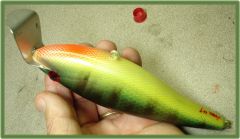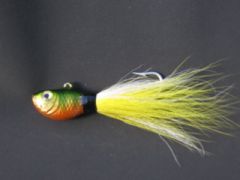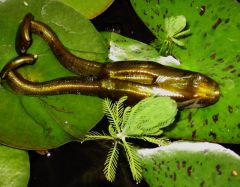-
Posts
1,854 -
Joined
-
Last visited
-
Days Won
9
Content Type
Profiles
Articles
TU Classifieds
Glossary
Website Links
Forums
Gallery
Store
Everything posted by fatfingers
-
Hoping someone has an internet source for glass rattles. The type I'm trying locate are the ones that are used in plastic tube baits. Anyone have a link?
-
That thing rocks. I'm with Riverman. I'd either hurt myself or catch something on fire if I ever tried to fabricate something like that. Got any pictures of the lips? Are they done after you punch them out on that device or are there a few more steps before the lips are done?
-
-
-
-
A prototype I came up with this past winter. Weighted with 2 177 grain 50 caliber roundballs, which I had to flatten because the bait is a bit narrow from the back to the belly. Tested it recently and it runs excellent; about 4 feet down, which is a great place for a jerkbait to go near submerged weeds and weed edges. Yellow sides, gloss black back, white pearl belly, watercolor stripes. Weight without hooks is about 2 ounces.
-
-
-
-

Four inch multi-species minnow bait...foiled emerald shiner pattern
fatfingers posted a gallery image in Hard Baits
-
-
-
That's an interesting story, Dean, and one of which I was unaware. It shows how we are constantly trying to "figure out" the fish...which is the foundation of the search for "the magic bait" and the basis of a multi-billion dollar industry. I always get a kick out of listening to Bill Dance and Roland Martin as they go about the business of explaining why the "bait of the week" is vastly different from all others that have sold before. Its all very entertaining, but there have actually been some very innovative baits offered commercially in the last 20 years or so. I've built a few "hunters" completely by accident. So far, the muskies have been less amused than I am.
-
Krylon makes a pretty decent spray sealer also.
-
Congratulations, Mr. J, and welcome to the boards. There's something special about catching fish with something you've made with your own hands. This board is also unique in a similar way. There is a comradarie here and one heck of lot of great builders. I've hung out here for several years and even now there is not a single week that goes by where I don't learn something new or a tip on how to do something better or easier. A lot of talent here, a lot of very smart people, willing to share ideas and shortcuts.
-
-
Goldenshiner, it is a serious concern for musky fishing in my opinion. I've had muskies really tear up baits on occasion. They can twist hooks, pierce a rock hard finish, and bend tail hook hangers. Also after being netted they will sometimes violently thrash in the net with one or more of the hooks caught on some portion of the net. The extra leverage they get in the net puts additional torque on the bait. I've spent a lot of time thinking about the acrylics in the last few months and even more so since I've been using them. I'm of the opinion that I will probably use acrylics only for smaller, more general purpose baits, and continue using enamels for the musky baits. The reasoning is simple...it is a lot of work to build a quality musky bait and I don't want to take the risk of having a bait ruined as far as the paint by having chosen a type of paint that may not hold up as well. I have a Tennessee Shad bait that was compromised when a musky twisted the tail hook hanger just a bit. It was one of my eariler baits and I had tried a type of primer that I had hope would penetrate the bait a bit to provide a water-tight seal. The primer alone did not provide a seal against water penetration and the water soaked into the bait causing it to swell a bit near the tail. The result was that the swelling caused the clear coat (Devcon2) to split...but the paint remained entirely intact. I dried the bait, resealed it with Devcon and it has caught several more muskies since. Lastly, musky fishing often involves trolling over sharp structure with dramatic changes in depth. As a result, it is more common to get snagged on rocks and stumps as compared to other types of trolling. Thus the baits are subject to more of a beating than walleye type lures, etc.
-
Rofish, the threadfin shad and the gizzard shad are common baitfish in many parts of the United States and are the food source for many species of freshwater fish. Both species have a dot on the shoulder behind the eye. Many bait makers, both commercial and basement guys like us, have adapted the "kill dot" to a variety of baits. Because the shad is a silvery shiney baitfish, it has a very strong tendency to change colors at various depths and under a variety of light conditions, so adding the kill dot to any bait color pattern is a pretty safe bet that it might add extra attraction to the bait. I build and fish mainly for muskies and the muskellunge very often follow and feed on the shad, sometimes as the primary forage for weeks or months at a time. Largemouth and smallmouth bass also feed on shad from time to time if they are available in any given body of water. The shad schools are nomadic and can be found in both shallow and deep water depending on light conditions, water temperatures, and reproduction cycles. Other bait fish have similar markings and some have other pronounced marking such as a pronounced lateral line.
-
You might consider starting with a silver base coat, then thin the white out and slowly fade a layer over the silver. Then add whatever other colors appeal to you ina shad bait...blue, gold, purple, etc. Usually less is more when trying to emulate gizzard shad or threadfin shad. Don't forget to add the kill dot on the shoulder of the bait toward the back about the same level as the eyes on the bait.
-
-
Recently I tried Createx for the first time. It was interesting because I started building hard baits two years ago and have never used anything but enamels. Both have advantages and disadvantages. Createx is a pleasure to use. No fumes, cleans up easily, but not really much easier than enamels. It is available locally in more color choices and require less mixing to achieve a given desired color because of the choices available. However, it doesn't seem to cover as quickly and sometimes requires heat/air "flashing" to get it to set up between layers...thus those layers must be applied much slower than enamels to get the same color density. It also has the same requirements for a solvent-based clear between coats, unless there is a water-based clear that is as effective as automotive clear as far as being impervious to water when its dry. Enamels seem to allow much more tweaking colorwise and dry much more rapidly between layers. I've had experience with hard baits that have been pierced by hooks or musky teeth and the enamel remained intact. When the outside clear coating was breached with enamels, I simply applied another coat of clear and the bait was as good as new again. I haven't had that experience with Createx baits yet, but I've read on this board that the water-based paint work is ruined when water gets under the clear coat. These are just my opinions on my limited experience with Createx and they are of course subject to change as I continue trying the stuff. Bottom line is that I will certainly be using both in the future to capitalize on the advantages of each.
-

Mathematical modeling and pure science of lure design
fatfingers replied to goldenshinner's topic in Hard Baits
I love that quote, Vodkaman. I think it describes a lot of us on this board. It should be posted as part of the header on the home page of this website as a graphic reminder for those poor, naive, unfortunates who wander in here innoncently hoping to build a bait or two. I think this will all evntually evolve into a new 12 Step Program... "Hi, I'm fatfingers and I'm a bait builder." Response from the smoke-filled room full of people with paint-stainded fingers: "Hi, fatfingers." -
Green Tiger, different tail shape:















